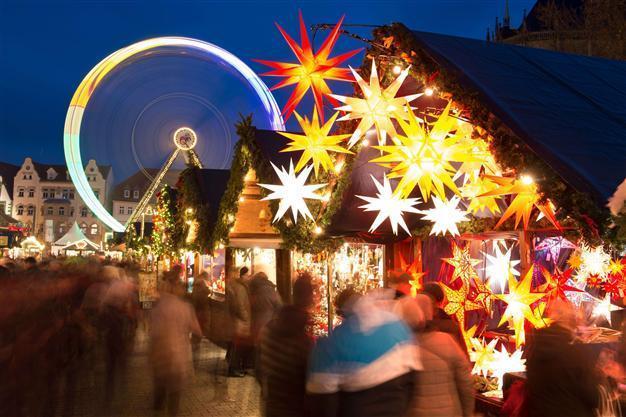Embers in December
Aylin Öney Tan - aylinoneytan@yahoo.com

People visit a Christmas market on November 24, 2015 in Erfurt. AFP PHOTO / DPA / SEBASTIAN KAHNERT
December in the northern hemisphere is the darkest of all months. As midwinter advent solstice days get shorter, nights get longer and colder. All one needs is the warmth of the glow of a fire. As each night gets darker, we need another candle to lift our spirits, another log in the fire to warm our hearts.In the old times that one log sometimes meant life; the glow of the ember was the light of survival. In pre-industrial Europe heating was a major problem during harsh winters and the symbolism of a burning log goes back to pre-Christian times, when gathering around the open hearth with a big burning log was the core of celebrations. The Old Norse “jól” festival marking the winter solstice is the inspiration behind the Yule Log cake, and the ubiquitous French “Bûche de Noël.” The origins of French log cake remain obscure, but in the nineteenth century the fashion flourished in Parisian patisseries. The fashion spread as far as Turkey, where it was adopted as the New Year’s cake in Istanbul’s French style pastry shops.
Now that we’re in the advent period, another way to warm our souls is with a glass of mulled wine. I tend to use the word Glühwein, as I’m more used to Germanic Weichnacht traditions. Glühwein gets its name again from the embers of dark and cold nights. The verb Glühend in German means to glow; it is a wine warmed over the embers, a wine that glows with the warmth of spices and a wine that makes you glow with rosy cheeks, slightly light-headed with the slow flow of alcohol in your veins. Swedish Glögg has the same meaning and is even more potent than its German counterpart, with the occasional pour of some aquavit to the concoction. Mulled wines of all sorts are dangerously delicious to drink. In the open air under falling fairy snowflakes, one can easily overdo the glasses and burn like fire, but feel like ashes the next day!
Here is a log recipe and a spicy pikey warm wine to heat your December like embers in a fireplace…
Bite of the Week
Fork of the Week: My ultimate visit this time of the year is to the Malatya Pazarı at the Spice Bazaar in Istanbul. This branch seems to have the widest variety of dried fruits, all essential for the perfect fruitcake for Christmas. Among all do not miss buying barberries, known as zereşk in Turkish. Their tangy taste will liven up any Christmas cake or dessert, especially if infused in an orangey liqueur like Cointreau or Grand Marnier. For a quick dessert have some infused in orange liquor, scoop ice cream with Kazandibi flavor into Martini glasses, dust with cinnamon, add a spoonfull of infused barberries on top together with the liqueur and enjoy. The red glow of plumbed barberries will add a shine to your table.
Cork of the Week: For a good Glühwein glowing with the warmth of sweet spices, add a bite with some peppercorns. After all, pepper is among the Christmas flavors, if you think about the delicious Swiss Pfeffernüsse, Swedish pepparkakor or Norwegian pepperkaker; it blends well with the rest of the essential spices like cinnamon, cloves and ginger. A fruity wine packed with forest fruit aromas is ideal, but never an oak-barrel aged one. I usually choose screw-top one-liter bottles and tend to make a strong infusion of spices with hot water first, then add the infusion to the wine and just heat through until warm without boiling, so that the alcohol in the wine does not evaporate and maintains its punch. Put one stick cinnamon, 10-12 cloves, 8-10 black or white peppercorns, two-three star anise, one piece of mace, a few slices of fresh ginger, the peel of a tangerine (preferably King or Clementine variety) and the peel of a red apple in a pot. Pour a glass of water over the spices and let simmer about 8-10 minutes. You may also add a teabag with spicy notes, such as chai or similar. Put the wine into a stainless steel pot, add the infusion together with the spices and peel, add sugar to taste, 4-5 tablespoons will be fine, heat through until little bubbles appear, take care not to boil. Serve in glass mugs with a thin orange slice.












